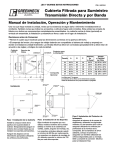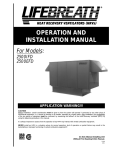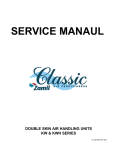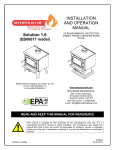Download Greenheck Fan PVF User's Manual
Transcript
RETAIN THESE INSTRUCTIONS FOR FUTURE REFERENCE Part # 461006 MODEL PVF INDIRECT GAS FIRED FURNACES FOR ENERGY RECOVERY UNITS Installation, Operation and Maintenance Manual R Refer to Part Number 460945 for any unit information other than that pertaining to the Indirect Fired Furnace. WARNING!!! Improper installation, adjustment, alteration, service or maintenance can cause injury or death. Read the installation, operating and maintenance instructions thoroughly before installing or servicing this equipment. CAUTION!!! Units are designed for outdoor installation only. DO NOT locate units indoors. Indirect Fired Gas Unit Installations Units are listed for installation in the United States and Canada • Installation of gas fired duct furnaces must conform with local building codes. In the absence of local codes, installation must conform to the National Fuel Gas code, ANSI Z223.1 or in Canada, CAN/CGA-B149 installation codes. • All electrical wiring must be in accordance with the regulation of the National Electric Code, ANSI/NFPA No. 70. • Unit is approved for installation downstream from refrigeration units. In these conditions, condensate could form in the duct furnace and provision must be made to dispose of the condensate. Shipping Check the unit for shipping damage. If any shipping damage is found, it should be reported to the last carrier and your local Greenheck representative. ® Location Recommendations 1. Do not install units in locations where flue products can be drawn into adjacent building openings such as windows, fresh air intakes, etc. Distance from vent terminal to adjacent public walkways, adjacent buildings, operable windows, and building openings shall conform with the local codes. In the absence of local codes, installation shall conform with the National Fuel Gas Code, ANSI Z223.1, or the CAN/CGA B-149 Installation Codes. 2. Building materials that will be affected by flue gases should be protected. 5. Local codes may supercede any of the above provisions. 6. Be sure that the minimum clearances to combustible materials are maintained. Unit Clearances to Combustible Materials Combustion blower discharge must be located 42 in. from any combustible materials. Venting 3. Avoid locating in an area where deep snow is likely to accumulate. During the winter months, keep snow clear on the access side of the unit to prevent any blockage of combustion air inlet or flue exhaust openings. 1. Do not modify or obstruct the combustion air inlet cover or the combustion blower weatherhood. 4. Maintain minimum horizontal clearance of 4 feet from electric meters, gas meters, regulators, and relief equipment. In Canada, the minimum clearance is 6 feet. 3. Do not add any vents other than those supplied by the manufacturer. 2. During the winter months, periodically clear snow from access side of unit to prevent blockage of the inlet and exhaust openings. Gas Connection Gas Supply Pressure Requirements Natural: 6 to 14 in. wg LP: 11 to 14 in. wg 1. Single furnaces (furnace input 100 to 400 MBH) have a single 3⁄4 inch connection. Double furnaces (furnace input 500 to 800 MBH) have two 3⁄4 inch connections, and triple furnaces (furnace input 1050 to 1200 MBH have three 3⁄4 inch connections. 2. When connecting the gas supply, the length of the run must be considered in determining the pipe size to avoid excessive pressure drop. Refer to a Gas Engineer’s Handbook for gas pipe capacities. 3. A drip leg should be installed in the pipe run to the unit. 4. Install an easily accessible ground joint union and a manual shut off valve (these are required by some local codes) for emergency shut off and easy servicing of the controls. 7. When leak testing pressures above 14 in. wg (1⁄2 psi), close the field installed shutoff valve, disconnect the furnace and its gas train from the gas supply line, and plug the supply line before testing. 8. When leak testing at pressures equal to or less than 14 in. wg (1⁄2 psi) close the field-installed shutoff valve to isolate the unit from the gas supply line before testing. From Gas Gas Cock Ground Joint Union To Controls 1/8 in. Plugged 6 in. Trap 5. A 1⁄8 inch NPT plugged tap shall be installed immediately ahead of the gas supply connection to the furnace. 6. After gas piping is completed, carefully check all piping connections for gas leaks. Use soap solution or equivalent for testing. DO NOT use a flame or other source of ignition to check for gas leaks. 2 Figure 1: Recommended Piping to Controls Electrical Connections WARNING!!! • Disconnect power supply before making wiring connections to prevent electrical shock and equipment damage. • All appliances must be wired strictly in accordance with wiring diagram furnished with the unit. Any wiring different from the diagram could result in a hazard to persons and property. • Any original factory wiring that requires replacement must be replaced with wiring material having a temperature rating of at least 105°C. 1. Installation of wiring must conform with local building codes. In the absence of local codes, installation must conform to the National Electric Code ANSI/NFPA 70-Latest Edition. Unit must be electrically grounded in conformance with this code. In Canada, wiring must comply with CSA C22.1, Canadian Electrical Code. 2. All furnaces are provided with a wiring diagram located on the inside of the access panel. Refer to this wiring diagram for all wiring connections. 3. The combustion blower motor will not run unless the furnace is turned on and the gas controls are calling for heat. Control Center Layout 9 1 1. Two-stage temperature controls - Controls the furnace stages based on the unit discharge temperature. 2. Combustion blower - Exhausts the products of combustion from the furnace tubes. 3. Ignition controller - Continually monitors, analyzes, and controls the proper operation of the gas burner. 2 3 4. Manifold pressure test port - Used for checking the manifold gas pressure. 5. Time Delay relay - Allows burner to stay at high fire for 10 seconds upon being lit. 4 6. Air pressure switch - Tests to ensure the combustion blower is operating. 5 6 7. Two-stage gas valve - Contains main pressure regulator, safety shut-off valves, and manual shut off knob. It controls the furnace to 50% or 100% fire. 8. Ignitor - Provides spark for burner ignition. 7 9. Flame Sensor - Ensures that each burner has ignited. 8 Figure 2: Furnace Control Center 3 Start-Up Procedure 1. Turn off power to the unit at the disconnect switch. Close all manual gas valves. 2. Check that all gas and electrical connections are weatherized. 3. Make sure that the combustion air inlet and the combustion blower discharge are free from obstructions. 4. Inspect the unit to make sure that no damage has occurred during installation. 5. With the furnace control center access panel removed, connect a “U” tube manometer to the manifold pressure test port as shown in Figure 2. This will be used for checking the manifold gas pressure. 6. Set the thermostat or discharge temperature controls to lowest setting. Sequence of Operation Power-up/Standby After power is supplied to the unit: 1. The ignition control will reset and perform a selfcheck routine. 2. The diagnostic LED will flash for up to four seconds. 3. The ignition control will begin scanning the thermostats. Heat Mode When the thermostat or discharge temperature controls call for heat: 1. The ignition control will check that the pressure switch for the combustion blower is open. 2. The combustion blower will be energized and the 15-second pre-purge begins. 3. The gas valve is energized and the igniter will spark for up to 10 seconds. Natural Gas - If a flame is not sensed during the trial for ignition, two additional trials will be attempted before going into lockout for one hour. LP Gas - If a flame is not sensed during the trial for ignition, the control will go into lockout for one hour. 4. When a flame is sensed, sparking stops immediately. The gas valve and combustion blower remain energized. 4 7. Open all manual gas valves including the combination gas valve and turn power on. 8. Call for heat with the thermostat or discharge temperature controls and allow the burner to light. Greenheck duct furnaces are equipped with an automatic spark ignition system which automatically lights the burner. DO NOT attempt to light the burners manually. 9. After the burner is lit, check to make sure that the supply blower is operating. 10.Verify that the gas controls sequence properly (see Sequence of Operation below). 11.Check the manifold gas pressure (see Burner Adjustments on pages 5 and 6). 5a. Two-stage control: The burner will light at 100% fire and remain there for 10 seconds. The thermostat will then operate the burners at high or low fire, depending on the demand for heat. 5b. Electronic Modulation - The burner will light at 100% fire and remain there for 10 seconds. The main burner gas valve will then modulate from 100% down to 50% as needed. If the burner remains on low fire for an extended period of time, the burner will shut off and re-light as necessary. 6. The ignition control constantly monitors the thermostat, pressure switch, and burner flame to assure proper operation. 7. When the thermostat or discharge temperature controls are satisfied, the main valve is deenergized and the combustion blower shuts off following a 30-second post-purge period. Recovery from Lockout The ignition control will automatically reset after 1 hour if the thermostat is still calling for heat. Prior to 1 hour, a manual reset (cycle power to unit) is required. The thermostat may be reset or the power interrupted for a period of 5 seconds. See page 7 for Ignition Control Diagnostics. Performance Data Air Temperature Rise Through Unit (°F) Model Number PVF 100 PVF 150 PVF 200 PVF 250 PVF 300 PVF 350 PVF 400 Input Output 20 25 30 35 40 (MBH) (MBH) 100 80 3704 2963 2469 2116 1852 150 120 5556 4444 3704 3175 2778 200 160 7407 5926 4938 4233 3704 250 200 9259 7407 6173 5291 4630 300 240 11111 8889 7407 6349 5556 350 280 12963 10370 8642 7407 6481 400 320 14815 11852 9877 8466 7407 45 50 1646 1481 2469 2222 3292 2963 4115 3704 4938 4444 5761 5185 6584 5926 55 CFM 1347 2020 2694 3367 4040 4714 5387 60 65 70 75 80 85 90 95 100 1235 1852 2469 3086 3704 4321 4938 1140 1709 2279 2849 3419 3989 4558 1058 1587 2116 2646 3175 3704 4233 988 1481 1975 2469 2963 3457 3951 926 1389 1852 2315 2778 3241 3704 871 1307 1743 2179 2614 3050 3486 823 1235 1646 2058 2469 2881 3292 780 1170 1559 1949 2339 2729 3119 741 1111 1481 1852 2222 2593 2963 Ratings shown are for elevations up to 2000 ft. For higher elevations, the input should be reduced by 4% per 1000 ft. of elevation above sea level. In Canada, from 2000 to 4500 ft in elevation, the unit must be derated to 90% of the input listed above. The unit shall also be used in accordance with standard CGA 2.17. Furnace Controls Staged Temperature Controls For Energy Recovery Units without Temperature Control Package The furnace stage controls are located in the furnace control center. One control is provided for each stage of heating. The discharge temperature setting is located on the control furthest to the left. The offset and differential settings for each stage are preset at the factory; however, field-adjustments may be made to get the best control for your application. See the literature provided with the controls for further information. For Energy Recovery Units with Temperature Control Package If two-stage control is ordered with a Temperature Control Package, the controller in the unit’s main control center will control the stages of heating. The temperature set point may be adjusted on the controller (See Temperature Controller IOM). Figure 3: Staged Controls Staged Burner Adjustments Setting Manifold Pressure for Two Stage Gas Control 1. Set the unit to high fire by setting the discharge temperature control or thermostat to its maximum setting. If the ambient temperature is warm, the unit may not stay at high fire. Solenoid High Fire Adjustment Low Fire Adjustment High Fire Terminal 2. Measure the burner manifold pressure at the manifold pressure test port (see Control Center Layout on page 3) using a “U” tube manometer. The pressure on high fire should be 3.5 in. wg for natural gas and 10 in. wg for LP gas. To change the pressure, adjust the regulator adjustment screw on the combination gas valve. 3. Set the unit to low fire by removing the wire from the high fire terminal on the combination gas valve. 4. The manifold pressure on low fire for natural gas should be 0.88 in. wg and 2.5 in. wg for LP gas. To change the pressure, use the low fire adjustment screw on the combination gas valve. Figure 4: Combination Gas Valve 5 Electronic Modulation Temperature Controls For Energy Recovery Units without Temperature Control Package A Discharge Temperature Dial is used for temperature control for electronic modulation. The temperature dial will be located in the furnace control center. For Energy Recovery Units with Temperature Control Package The Temperature Controller in the unit’s main control center will provide the electronic modulation control. High and Low Fire Settings for Electronic Modulation Check the high and low gas pressures on initial start up per the instructions below. These settings are pre-set at the factory, but should be adjusted in the field if necessary. Set the high fire first and the low fire second. The low fire must always be checked if the high fire is changed. Modulating Valve Low fire adjustment B Combination Gas Valve High fire adjustment Figure 5: Electronic Modulation Valves A 1. Set the unit to high fire by placing a jumper between terminals 7 and 8 on the Maxitrol amplifier. 2. Measure the burner manifold pressure at each furnace at the pressure test port (see Figure 2) using a high quality manometer that can measure low gas pressures. The pressure at high fire should be 3.5 in. wg for natural gas and 10.0 in. wg for LP Gas. To change the pressure, adjust the high fire screw on the combination gas valve. 3. To get the unit to low fire: Remove the wire from terminal 3 on the amplifier and isolate it from touching anything. Set the discharge temperature selector to the highest setting. If there is a room override thermostat, turn the dial to the highest setting. 4. Measure the manifold pressure on low fire, it should be 0.88 in. wg for natural gas and 2.5 in. wg for LP gas. 5. To adjust the low fire, remove the bypass cap (A) and turn screw (B) as shown in diagram. Adjust the screw indicated in Figure 5 on the modulating valve. 6. Reconnect wire to terminal 3. 7. Remove jumper and place all wires back to where they were and plug the manifold pressure port. 6 Troubleshooting Ignition Control Diagnostic LED During normal operation, the LED is shut off. The LED will be on or flashing during a fault condition. If a fault condition is occurring, turn the unit off and on again. If the LED is still flashing, refer to the following troubleshooting section. LED Indication Steady on 1 flash 2 flashes 3 flashes Error Mode Internal control failure Air flow fault Flame with no call for heat Ignition lockout Airflow Fault (1 Flash) An airflow fault may occur for the following reasons: • An airflow switch continually monitors the combustion airflow during an ignition sequence. During the initial call for heat, if the pressure switch contacts are in the closed position for 30 seconds without an output to the combustion blower, an airflow fault will be declared. The control will remain in this mode with the combustion blower off. • After the combustion blower output (L1 and IND) is energized and the airflow switch remains open for more than 30 seconds, an airflow fault will be declared. The control will stay in this mode with the combustion blower on, waiting for the airflow switch to close. • If the airflow signal is lost while the burner is firing, the control will immediately de-energize the gas valve and the combustion blower will remain on. If the call for heat remains, the control will wait for proper airflow to return. If proper airflow is not detected after 30 seconds, an airflow fault will be declared. If proper airflow is detected at any time, a normal ignition sequence will begin. Once proper airflow is detected, the normal Sequence Of Operation for ignition will follow (see page 4). Flame Fault (2 Flashes) If the main valve fails to close completely and maintains a flame, the full-time flame sense circuit will detect it and energize the combustion blower. Should the main valve later close completely and remove the flame signal, the combustion blower will be de-energized. Ignition Lockout (3 Flashes) Possible Cause Solution Manual gas valve not open Open manual valve Air in the gas line Bleed gas line Supply gas pressure too high or too low Check that supply pressure is between 6 in. wg and 14 in. wg for natural gas and 11 in. wg and 14 in. wg for LP. Loose wire connections Check for tight wire connections. No spark: a. Transformer failure a. Check primary and secondary voltages of transformer. Replace if necessary. b. Spark electrode b. Ensure spark gap is 1⁄8 in. and ceramic insulator is not cracked. Replace if necessary. Electrode is NOT field-adjustable. c. Spark cable shorted to ground c. Replace spark cable d. Ignition controller not grounded d. Check that the ignition controller is grounded to the furnace control center. High limit control tripped Check unit airflow and manifold pressure. Faulty combination gas valve If 24 volts is measured between terminals MV and common, but valve remains closed, replace valve. Faulty ignition control Check diagnostic LED for steady on and for voltage between V1 and V2. If no voltage is present, replace ignition control. 7 Routine Maintenance CAUTION!!! Turn off all gas and electrical power to the unit before performing any maintenance or service operations to this unit. Combustion Blower Motor Motor maintenance is generally limited to cleaning. Cleaning should be limited to exterior surfaces only. Removing dust and grease build-up on the motor housing assures proper motor cooling. Use caution and do not allow water or solvents to enter the motor or bearings. Under no circumstances should motors or bearings be sprayed with steam, water or solvents. The motor bearings are pre-lubricated and sealed, requiring no further lubrication. Burners and Orifices Before each heating season, examine the burners and gas orifices to make sure they are clear of any debris such as spider webs, etc. Clean burner as follows: • Turn off both electrical and gas supplies to the unit. • Disconnect union between manifold and gas valve. • Remove manifold and burner assembly. • Inspect and clean orifices and burners as necessary. Avoid using any hard or sharp instruments which could cause damage to the orifices or burners. - Remove any soot deposits from the burner with a wire brush. - Clean the ports with an aerosol degreaser or compressed air. - Wipe the inside of the burner clean. Cleaning the burner with a degreaser will slow the future buildup of dirt. • Before reinstalling the burner assembly, look down the heat exchanger tubes to make sure they are clear of any debris. • Reinstall manifold and burner assembly, reconnect wire leads, and gas supply piping. • Turn on the electrical power and gas supply. • Follow the start-up procedure to light the burners and verify proper operation. Heat Exchanger The heat exchanger should be checked annually for cracks and discoloration of the tubes. If a crack is detected, the heat exchanger should be replaced before the unit is put back into operation. If the tubes are dark gray, airflow across the heat exchanger should be checked to make sure the blower is operating properly. Flue Collector Box The flue passageway and flue collector box should be inspected prior to each heating season and cleared of any debris. Electrical Wiring The electrical wiring should be checked annually for loose connections or wiring deterioration. Replacement Parts When ordering replacement parts, include the complete unit model number and serial number listed on the unit rating plate. Warranty Greenheck warrants this equipment to be free from defects in material and workmanship for a period of one year from the purchase date. Any units or parts which prove to be defective during the warranty period will be repaired or replaced at our option. The motor is warranted by the motor manufacturer for a period of one year. Should the motor prove defective during this period, it should be returned to an authorized motor service station. Greenheck will not be responsible for any installation or removal costs. Copyright © 2001 Greenheck Fan Corp. ERCH - PVF IOM FS Rev1 July 2001
















